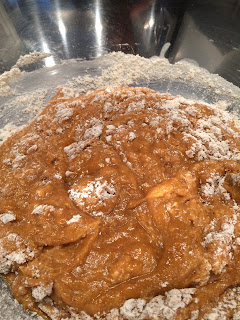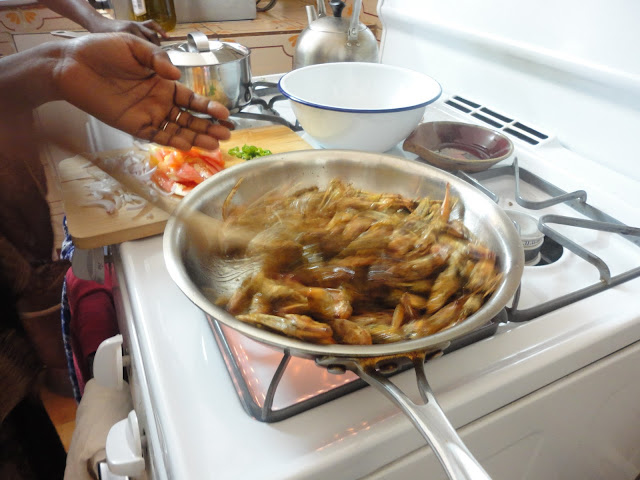After two years in Niger and another two in Jerusalem, I am back in the States for the next couple of years. It isn't 2016, yet, but I figure that major transitions in your life are good points at which to make new resolutions. Keeping up with this blog is one of mine for this domestic tour!
My diet and cooking habits change with each of my "homes." I try to only use what I can find in the stores wherever I am living. The U.S. has an amazing variety of ingredients, so I'm happy that I'll be able to keep up those culinary habits I picked up in Jerusalem, Niger, Morocco, and Japan.
Speaking of being thankful, we just celebrated our first Thanksgiving back in the States in five years. While I always celebrate my holidays wherever I am, there is something super special about being able to celebrate them in your homeland. For starters, my neighbors didn't look at me quizzically when I said "Happy Thanksgiving!"
I haven't hosted Thanksgiving in a long time. I had almost forgotten that the leftovers from your Thanksgiving feast are just as delicious and fun to prepare as the main event itself. On Friday, I made a nice batch of broth from the turkey carcass, giblets, neck, and vegetable scraps from side dish preparations. I measured it out into mason jars and froze it for later use. On Saturday I made a southwestern inspired turkey hash. And, today - Sunday - I am making pumpkin pie muffins.
My new house smells awesome.
This recipe is adapted from Ellie Krieger's The Food You Crave: Luscious Recipes for a Healthy Life. I've used it in Niger and Jerusalem, so I am pretty certain that you can make these muffins almost anywhere in the world. In Niger, I would buy chunks of fresh pumpkin at the market and cook it down until it was soft enough to use. You can substitute honey or maple syrup for the molasses. If you don't have all of the spices, just omit the one you don't have and increase the others a little. I imagine you could use minced candied or dried ginger if you don't have ground ginger. Nutmeg could be substituted with more clove, cinnamon, or allspice.
Ingredients
1 cup all purpose flour
1 cup whole-grain pastry flour or whole-wheat flour
1 teaspoon baking soda
1/2 teaspoon salt
1 teaspoon ground cinnamon
1/2 teaspoon ground ginger
1/4 teaspoon ground cloves
1/8 teaspoon ground nutmeg
3/4 cups firmly packed brown sugar
3 tablespoons unsulfured molasses (or honey or maple syrup)
1/4 cup canola oil (or olive oil)
2 large eggs
1 cup solid-packed pumpkin
1 teaspoon vanilla extract
3/4 cup buttermilk (or measure out 3/4 milk squeeze in a little lemon and allow it to sour for while you prep the other ingredients)
1/4 cup unsalted raw pumpkin seeds (If you're industrious, you would have seeds saved from Halloween pumpkin carving. I'm not, so I used pecan halves. You can omit the nuts if you want. They're just for decoration).
Directions
Preheat the oven to 400F/205C. Grease a muffin pan with room-temperature butter or oil.
In a medium bowl, whisk together the flours, baking soda, salt, and spices.
In a large bowl, combine the sugar, molasses, oil, and one of the eggs. Add the other egg and whisk well. Stir in the pumpkin and vanilla.
Alternate stirring in half of the flour, then half of the buttermilk, then the remaining flour, and finally the rest of the buttermilk.


Pour the batter into the greased muffin tin and bake for about 20 minutes or until a toothpick inserted in the center of a muffin comes out clean.
Once they're done, let the muffins cool on a wire rack for about 5 to 10 minutes. Run a knife around the edge of the muffins to pop them out of the tin.
You can keep these in a sealed container for about 3 days in the refrigerator or 3 months in the freezer.
Enjoy!
My diet and cooking habits change with each of my "homes." I try to only use what I can find in the stores wherever I am living. The U.S. has an amazing variety of ingredients, so I'm happy that I'll be able to keep up those culinary habits I picked up in Jerusalem, Niger, Morocco, and Japan.
Speaking of being thankful, we just celebrated our first Thanksgiving back in the States in five years. While I always celebrate my holidays wherever I am, there is something super special about being able to celebrate them in your homeland. For starters, my neighbors didn't look at me quizzically when I said "Happy Thanksgiving!"
I haven't hosted Thanksgiving in a long time. I had almost forgotten that the leftovers from your Thanksgiving feast are just as delicious and fun to prepare as the main event itself. On Friday, I made a nice batch of broth from the turkey carcass, giblets, neck, and vegetable scraps from side dish preparations. I measured it out into mason jars and froze it for later use. On Saturday I made a southwestern inspired turkey hash. And, today - Sunday - I am making pumpkin pie muffins.
My new house smells awesome.
This recipe is adapted from Ellie Krieger's The Food You Crave: Luscious Recipes for a Healthy Life. I've used it in Niger and Jerusalem, so I am pretty certain that you can make these muffins almost anywhere in the world. In Niger, I would buy chunks of fresh pumpkin at the market and cook it down until it was soft enough to use. You can substitute honey or maple syrup for the molasses. If you don't have all of the spices, just omit the one you don't have and increase the others a little. I imagine you could use minced candied or dried ginger if you don't have ground ginger. Nutmeg could be substituted with more clove, cinnamon, or allspice.
Ingredients
1 cup all purpose flour
1 cup whole-grain pastry flour or whole-wheat flour
1 teaspoon baking soda
1/2 teaspoon salt
1 teaspoon ground cinnamon
1/2 teaspoon ground ginger
1/4 teaspoon ground cloves
1/8 teaspoon ground nutmeg
3/4 cups firmly packed brown sugar
3 tablespoons unsulfured molasses (or honey or maple syrup)
1/4 cup canola oil (or olive oil)
2 large eggs
1 cup solid-packed pumpkin
1 teaspoon vanilla extract
3/4 cup buttermilk (or measure out 3/4 milk squeeze in a little lemon and allow it to sour for while you prep the other ingredients)
1/4 cup unsalted raw pumpkin seeds (If you're industrious, you would have seeds saved from Halloween pumpkin carving. I'm not, so I used pecan halves. You can omit the nuts if you want. They're just for decoration).
Directions
Preheat the oven to 400F/205C. Grease a muffin pan with room-temperature butter or oil.
In a medium bowl, whisk together the flours, baking soda, salt, and spices.
In a large bowl, combine the sugar, molasses, oil, and one of the eggs. Add the other egg and whisk well. Stir in the pumpkin and vanilla.
Alternate stirring in half of the flour, then half of the buttermilk, then the remaining flour, and finally the rest of the buttermilk.


Pour the batter into the greased muffin tin and bake for about 20 minutes or until a toothpick inserted in the center of a muffin comes out clean.
Once they're done, let the muffins cool on a wire rack for about 5 to 10 minutes. Run a knife around the edge of the muffins to pop them out of the tin.
You can keep these in a sealed container for about 3 days in the refrigerator or 3 months in the freezer.
Enjoy!






























